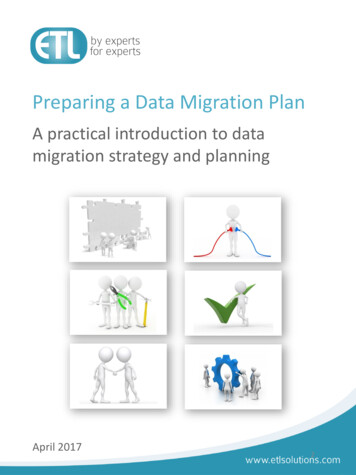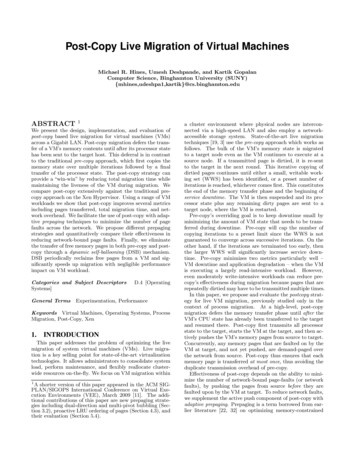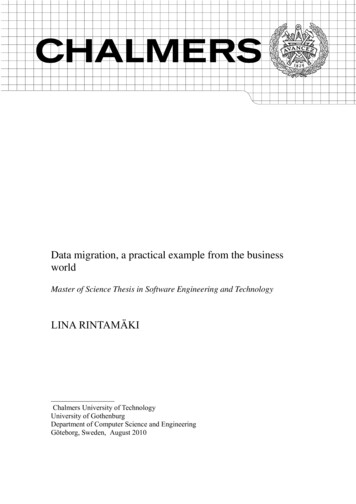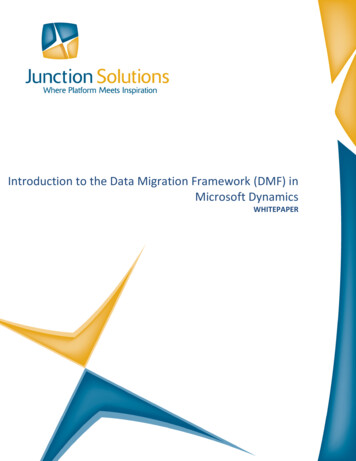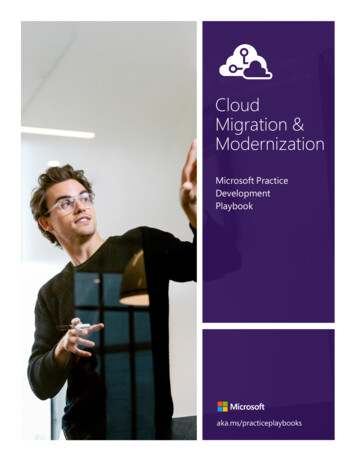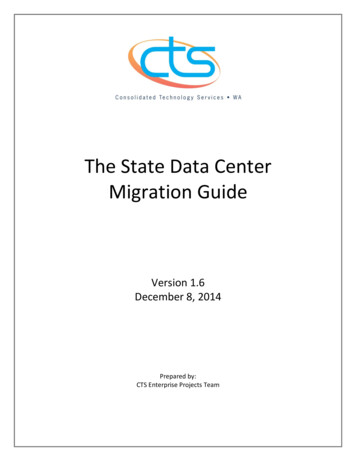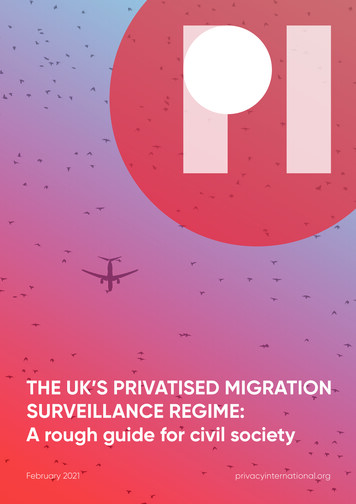
Transcription
THE UK’S PRIVATISED MIGRATIONSURVEILLANCE REGIME:A rough guide for civil societyFebruary 2021privacyinternational.org
THE UK’S PRIVATISED MIGRATION SURVEILLANCE REGIME: A rough guide for civil societyABOUT PRIVACY INTERNATIONALGovernments and corporations are using technology to exploit us. Their abuses ofpower threaten our freedoms and the very things that make us human. That’s whyPrivacy International campaigns for the progress we all deserve. We’re here to protectdemocracy, defend people’s dignity, and demand accountability from the powerfulinstitutions who breach public trust. After all, privacy is precious to every one of us,whether you’re seeking asylum, fighting corruption, or searching for health advice.So, join our global movement today and fight for what really matters:our freedom to be human.Open access. Some rights reserved.Privacy International wants to encourage the circulation of its work as widely as possible while retainingthe copyright. Privacy International has an open access policy which enables anyone to access its content onlinewithout charge. Anyone can download, save, perform or distribute this work in any format, including translation,without written permission.This is subject to the terms of the Creative Commons Licence Deed:Attribution-Non-Commercial-No Derivative Works 2.0 UK: England & Wales. Its main conditions are: You are free to copy, distribute, display and perform the work; You must give the original author (‘Privacy International’) credit; You may not use this work for commercial purposes; You are welcome to ask Privacy International for permission to use this work for purposesother than those covered by the licence.Privacy International is grateful to Creative Commons for its work and its approach to copyright.For more information please go to www.creativecommons.org.Photo by John Rodenn Castillo on UnsplashPrivacy International62 Britton Street, London EC1M 5UY, United KingdomPhone 44 (0)20 3422 4321privacyinternational.orgPrivacy International is a registered charity (1147471), and a company limited by guarantee registered in England and Wales (04354366).2
THE UK’S PRIVATISED MIGRATION SURVEILLANCE REGIME: A rough guide for civil societyCONTENTSINTRODUCTION 51. WHO’S INVOLVED? 7a. Home Office 8b. UK Visas and Immigration 8c. The Border Force 8d. Immigration Enforcement 9e. Her Majesty’s Passport Office 9f. Digital, Data and Technology 92. “BACK-END” SYSTEMS 10a. Existing Databases of Relevance 11b. Databases of Relevance in Development 14i. Digital Services at the Border (DSAB) / Future Borders andImmigration Systems (FBIS) 15ii. Immigration Platform Technologies (IPT) 19iii. Home Office Biometrics (HOB) 21iv. National Law Enforcement Data Programme (NLEDP) 223. “FRONT-END” TOOLS 24a. Mobile Scanners 25b. Status Checking 29c. Border Surveillance 30d. Language analysis 313
THE UK’S PRIVATISED MIGRATION SURVEILLANCE REGIME: A rough guide for civil societye. Mobile Phone Extraction 32f. Hacking 34g. Wi-Fi Analysis 35h. Communications Data Surveillance 35i. Surveillance Vans 36j. Intelligence Sharing Software 36k. Data Analytics 37l. Data Analytics 37m. Data Brokers 384. INTERNATIONAL OPERATIONS 40a. International Biometric Data Sharing 41b. Surveillance outsourcing 435. RESEARCH RESOURCES 456. LIST OF COMPANIES MENTIONED IN THE GUIDE 474
THE UK’S PRIVATISED MIGRATION SURVEILLANCE REGIME: A rough guide for civil societyINTRODUCTIONThe ability to police and ‘control’ the UK’s borders was a central issue for votersin the UK Brexit vote, and is once again headline news with coverage focusingon migration across the Channel.Regular stories of the Home Office losing track of “foreigners” or having “no cluehow many illegal immigrants there are” feed a notion that the UK’s immigrationsystem is fundamentally ‘broken’.Perceived and real failures of how the UK tracks people in the immigrationsystem are vulnerable to simplification and dangerous rhetoric in part becauseof its opaqueness. Already managed and enforced by a confusing complexof government departments, agencies, infrastructure, and contractors, thesituation is not helped by the fact that many of the key actors involved areresistant to transparency and that Brexit is demanding yet more changes.There is no doubt there are severe problems at the Home Office, somethingrecognized by numerous oversight bodies and inquiries. Windrush and the factthat people who rely on the asylum system are left waiting longer than ever aretwo examples.But far from being powerless or weak, the reality is that the system is vast,with annual expenditure exceeding 2 billion. UK authorities are able to callon intrusive surveillance powers matching those of anyone else in the world.Immigration agencies are equipped with advanced tools of surveillance, andsupplemented by a ‘hostile environment’ which extends the duty of controllingborders to landlords, employers, teachers, and doctors.At the same time however, the Home Office has an abysmal record ondelivering IT projects, with the effect that it fails to provide basic and vitalservices for people while continuing to award lucrative contracts to big armsand surveillance companies which enjoy minimal scrutiny and are seldom heldaccountable in the public discourse.5
THE UK’S PRIVATISED MIGRATION SURVEILLANCE REGIME: A rough guide for civil societyProviding a realistic perspective of the powers and technology available to UKagencies and the problems across the system are important for dispelling mythsand dangerous narratives.Below, we try to provide a rough guide to how the UK’s borders, immigrations,and citizenship system tracks and spies on people, and which companies profit.The first section briefly outlines the main departments and units involved. Itthen describes various databases which are used to process immigration data,track people through the borders, immigrations, and citizenship system, or whichare relevant because they enable forms of surveillance by law enforcement orimmigration authorities. These are referred to for the purposes of this guide asthe “back-end” systems.The following section then describes surveillance and tracking tools availableto officers and agencies themselves, referred to here as the “front-end” tools. Asection on international operations which are used to support surveillance in theUK is provided, followed by a list of relevant other resources.6
THE UK’S PRIVATISED MIGRATION SURVEILLANCE REGIME: A rough guide for civil society1. WHO’S INVOLVED?KEY FACTS: In 2017-18, the UK Visas and Immigration (UKVI) spent 1.1 billion, but earned 1.6 billion in income from things like charging substantial visa fees Immigration Enforcement heads up the investigation of and removal /deportation of people who are in the UK with irregular status. In 201718, the department spent 430 million, and had an income of 33million through schemes involving charging “customers” to comply withimmigration rule. In addition to the operational departments at the Home Office, a separateentity known as an “enabler” called Digital, Data and Technology whichoversees a range of tech projects relating to the immigration and asylumsystem.7
THE UK’S PRIVATISED MIGRATION SURVEILLANCE REGIME: A rough guide for civil societya. Home OfficeThe Home Office is in charge of the UK borders, immigration, and citizenshipsystem.In 2019, it issued 3.2 million visas to people around the world: 76% of them werefor people who were visiting (2.43 million), 9% for students, 6% for workers, andthe rest for family and other reasons. In the same period, 35,566 people claimedasylum in the UK – amounting to the equivalent of just over 1% of the amount ofvisas issued for other reasons.A large influence on their operations is the idea that the Home Office is capableof being run as a business: in 2015 it signed up to the idea that it could be ‘selffunded’ by charging its ‘customers’. Predictably, it has since told the IndependentChief Inspector of Borders and Immigration that it has “reigned back on selffunding, moving from an objective for self-funding by 2019-20 to an ambition toincrease the extent to which [the borders, immigration, and citizenship system] isfunded by those who use its services.”Nevertheless, the policy permeated across the Home Office, pushing agencies toraise fees and charge “customers” for new services.There are four main operational departments governing this system.b. UK Visas and Immigration (UKVI) manages visa, citizenship, and asylumapplications, and had over 9000 staff in 2019.In 2017-18, the department spent 1.1 billion, but earned 1.6 billion in incomefrom things like charging substantial visa fees.c. The Border Force is responsible for managing people and goods entering theUK and collecting revenue from trade crossing the border.It had just under 8200 staff in 2019. In 2017-18, the department spent 522 million,and had an income of 22 million, from schemes such as charging carriers andpeople for expedited transit through the UK border.8
THE UK’S PRIVATISED MIGRATION SURVEILLANCE REGIME: A rough guide for civil societyd. Immigration Enforcement heads up the investigation of and removal /deportation of people who are in the UK with irregular status. The department’sstated aim is that it wants “to reduce the size of the illegal population and theharm it causes”.It had over 5000 staff as of 2019. In 2017-18, the department spent 430million, and had an income of 33 million through schemes involving charging“customers” to comply with immigration rules. For example, employers and localauthorities could pay Immigration Enforcement officials to do things like checkthe immigration status of people, including when they’re applying for supportfrom local authorities.e. Her Majesty’s Passport Office (HMPO) issues passports and had over 3600 staffin 2019. In 2017-18, the department spent 263 million, but earned 435 millionfrom passport fees and providing customer service.f. Digital, Data and Technology: in addition to the operational departments atthe Home Office, there is a separate entity known as an “enabler” called Digital,Data and Technology which “designs, builds and develops services for the rest ofthe department and for government”. Made up of around 2500 staff, it overseesa range of tech projects relating to the immigration and asylum system.9
THE UK’S PRIVATISED MIGRATION SURVEILLANCE REGIME: A rough guide for civil society2. “BACK-END” SYSTEMSKEY FACTS The Home Office is currently developing several large IT systemswhich will be used to replace existing systems that track individualsthroughout the borders, immigration, and customs system and enablethe use of surveillance tools by relevant units and officers. Large tech and arms companies compete for supplying staff andvague services to the programme, but provide little insight as to whatthe firms are actually supposed to deliver. By converging facial, DNA, and fingerprint data into a single platform,biometric data will be more easily available to more agencies.10
THE UK’S PRIVATISED MIGRATION SURVEILLANCE REGIME: A rough guide for civil societyA. EXISTING DATABASES OF RELEVANCEThe following databases are used by various agencies across the UK’s borders,immigration, and citizenship system and are referenced later in this guide. Manyof these are aimed for security purposes and not for immigration or bordermanagement, but may nevertheless be used in some way to that end. This list isnon-exhaustive. The National DNA Database (NDNAD), which holds around 6.3 millionDNA profiles of subjects in criminal cases, some of whom have not beenconvicted of a crime and profiles of victims, as well as marks from crimescenes. The Immigration and Asylum Biometric System (IABS), which holdsaround 25 million fingerprints and faces, for example collected byUK Visas and Immigration (UKVI), including biographic information,fingerprints, and facial images as part of asylum, visa, or BiometricResidence Permit (BRP) applications. Developed by the tech giant IBMin 2009. Law Enforcement and Security Biometrics System (IDENT1), the maincriminal fingerprinting database used by law enforcement in the UK,which in 2018 held the biometrics of around 8 million people mostlybecause they were arrested in the UK, and developed by US armscompany Northrop Grumman. The Case Information Database (CID), the main caseworking andoperational database at the Home Office. It is used throughout theDepartment “to record personal details of all foreign nationals whopass through the immigration system”. It is being replaced as it is proneto errors, unstable, and unable to interface with other systems,11
THE UK’S PRIVATISED MIGRATION SURVEILLANCE REGIME: A rough guide for civil society The Asylum Support System (ASYS), containing details about asylumseekers applying for and receiving support. Warnings Index: A watchlist developed originally in 1995 whichtracks people with “previous immigration history, those of interestto detection staff, police or matters of national security”, accordingto the Independent Chief Inspector of Borders and Immigration. In2019, a whistle-blower highlighting a toxic workplace culture at anasylum management unit at the Home Office told the Guardian thatemployees without security clearance had been accessing the system.It is managed by the Warnings Index Control Unit (WICU) and was in2015 maintained by Fujitsu. “MI5 database”: the whistleblower also told the Guardian that staff atthe unit had access to an IT system operated by MI5, the UK’s domesticintelligence agency, though there is no information available aboutwhat this system is, what data it contains, its size, or purpose. Semaphore: A database developed by IBM in use since 2004 whichcompares data from air and other carriers against the Warnings Indexfor matches, in process of being replaced. In 2019 the Home Officesigned a 45m 33-month contract extension with IBM for the system,according to the Register.12
THE UK’S PRIVATISED MIGRATION SURVEILLANCE REGIME: A rough guide for civil society Initial Status Analysis (ISA) database: developed in 2015 as part of theExit Checks Programme (used to enable to screening of people leavingthe UK), it is used to cross check outbound and inbound travel datasent to the Semaphore database by carriers with “data recorded onother Home Office immigration-related systems”, in order to check aperson’s immigration compliance status. It contains “travel historiesthat consist of an individual’s travel in or out of the country, togetherwith data relating to their immigration status, such as periods ofleave granted.” This includes Advance Passenger Information (API),widely-used passenger data submitted in advance of travel for mostscheduled aviation journeys, and Travel Document Information (TDI),passenger data collected at the point of departure for other modesof transport. In addition, it includes data from “case working systemsrelating to (out-of-country) entry clearance visa application caseworkand (in-country) casework e.g. on extensions of leave to remain”,biometric details submitted prior to visa applications, and passportexaminations data collected upon entry into the UK. This data helpsmitigate any gaps in inbound API coverage.13
THE UK’S PRIVATISED MIGRATION SURVEILLANCE REGIME: A rough guide for civil societyB. DATABASES OF RELEVANCE IN DEVELOPMENTThe Home Office is currently developing several large IT systems which will beused to replace existing systems that track individuals throughout the borders,immigration, and customs system and enable the use of surveillance tools byrelevant units and officers.The Department currently manages ten major projects which fall within the“Government Major Projects Portfolio” because they are considered the “largest,most innovative and highest risk projects and programmes delivered bygovernment.” Of these, four directly relate to the technological infrastructureunderpinning the borders, immigration, and citizenship system: Digital Services at the Border (DSAB) / Future Borders and ImmigrationSystems (FBIS) Immigration Platform Technologies (IPT) Home Office Biometrics (HOB) National Law Enforcement Data Programme (NLEDP)The National Audit Office concluded in 2018 that the Home Office “has a poorrecord of delivering IT projects on time and on budget” – and the situation doesnot appear to have significantly improved.The Infrastructure and Projects Authority, which oversees the delivery of allmajor projects across government, carries out an annual review of these projects,grading them with the likelihood of successful delivery and level of associatedrisks. Ratings are categorised into five groups, which span a range from Redto Green.In 2020, three of these four projects (DSAB, IPT, & NLEDP) were rated “Amber/Red”,meaning that the “Successful delivery of the project is in doubt, with major risksor issues apparent in a number of key areas” requiring urgent action.14
THE UK’S PRIVATISED MIGRATION SURVEILLANCE REGIME: A rough guide for civil societyOnly the Home Office Biometrics programme was rated “Amber”, meaningthat “Successful delivery appears feasible but significant issues already exist,requiring management attention.”i. Digital Services at the Border (DSAB) / Future Bordersand Immigration Systems (FBIS)Digital Services at the Border (DSAB), a programme within the Digital, Data andTechnology unit, aims to build a system to gather data on people and goodscoming into and out of the UK and to share that information with the BorderForce, police and intelligence agencies.The aim is to replace a number of obsolete IT systems, including Semaphore.A disastrous 2003 programme known as “e-borders”, which was supposed todevelop a screening system to analyse data supplied by plane, train and ferrycarriers was cancelled by 2015 after the Home Office had spent 830 million on itwithout delivering large parts of the system.The Home Office subsequently spent 35 million fighting a legal challengebrought by one of the contractors - US arms company Raytheon - whichwas ultimately awarded 150 million of public money in a settlement with theHome Office.Having failed to replace the systems, the Home Office then spent an additional 303 million on upgrading the old systems, including Semaphore and theWarnings Index, between 2011-12 and 2014-15, having to rely on them despitethem requiring “extensive manual effort” and leading to “duplication of effort”,according to the NAO.Projected to cost some 346 million in total, DSAB is the latest attempt to replacethese legacy systems, aiming to “gather and act on data from those peopleand entities crossing the border, both inbound and out; and provide timely andaccurate data to those who need to access/use it.” According to tender andcontract notices available on the UK government’s portal, large tech and armscompanies compete for supplying staff and vague services to the programme,but provide little insight as to what the firms are actually supposed to deliver.The programme was supposed to end in 2019.15
THE UK’S PRIVATISED MIGRATION SURVEILLANCE REGIME: A rough guide for civil societyIn 2018, following the UK’s decision to leave the EU, the Home Office addedmore technological requirements to the programme in order to process moredata from EU passengers under a programme called the Future Border andImmigration System (FBIS).In December 2020, the National Audit Office reported that by March 2019 – theend date of DSAB - only an early version of Border Crossing, a system supposedto replace the Warnings Index, was in operation. Two planned systems, supposedto replace Semaphore and a system for tracking freight, had not been realisedbecause of an “expanding scope and lack of clarity over the scope of relatedprojects”, including how the Department “would hold data provided by lawenforcement and other agencies.”Because of further problems delivering all the systems due to “scope creep andpoor programme performance”, the National Audit Office noted that a decisionto reset the entire programme was taken in 2019 to reduce the scope and pushback delivery until 2022.The NAO concludes that that the estimated “net impact of not delivering to itsoriginal timetable of March 2019 is an additional cost of 173 million between2014-15 and 2021-22.”In 2020, it was announced that 113m has been provided for a newly establishedFuture Borders and Immigration Systems programme, aimed at delivering “aworld leading, data driven, digital border” controlling the entry of EuropeanEconomic Area citizens once free movement ends with Brexit.Throughout this time, various surveillance and arms companies have woncontracts for delivering services under both the DSAB and FBIS programmes.UK arms firm BAE Systems won a 4.9 million contract in 2018, for example, to“supply the capability to deliver discrete work packages aligned to the DSABprogramme roadmap”, while US security contractor CACI won another 4.9million contract in April 2020 to “deliver a supportable end to end service”.16
THE UK’S PRIVATISED MIGRATION SURVEILLANCE REGIME: A rough guide for civil societySum of Home Office expenditure over 25k on CACI, 2015 - 2020. Sums based on data availablefrom fice-spending-over-25000-2020and previous years.US data firm Teradata won a 1.78 million contract in 2017 (lasting until 2019)to deliver a “Big Data” capability: a copy of the contract obtained by PrivacyInternational under freedom of information rights similarly provides little insightinto the programme and Teradata’s role within it.In 2019, McKinsey & Company were awarded a 1.38 million contract for “scoping,planning and initial delivery” of the FBIS programme under a single tender,while UK-based AHE Partnership were awarded a 230,000 in October 2020 forplanning and other services.Because of the failure to deliver the programme by 2019, as reported by theRegister, the Home Office signed a 45 million contract with IBM in 2019 to extendthe use of Semaphore.17
THE UK’S PRIVATISED MIGRATION SURVEILLANCE REGIME: A rough guide for civil societySum of Home Office expenditure over 25k on IBM, 2015 - 2020. Sums based on data availablefrom fice-spending-over-25000-2020and previous years.In addition to these programmes at the Home Office, in September 2020 theGuardian reported that a borders unit at the Cabinet Office had awardedPalantir, a US surveillance firm notorious for contracting with the Immigrationand Customs Enforcement (ICE) agency in the US, a contract to “monitor anypotential impacts resulting from border controls being imposed by EU memberstates on goods or people coming from the UK.”A contract notice later published by the Government states that Palantir willprovide the services in two phases. Phase one involves scoping the technicalfeasibility of using data and metadata from border databases acrossgovernment departments and commercial third parties and integrating theminto Palantir’s Foundry software. This “Border Flow Tool” is aimed at providing“a situational awareness capability at the border through the means ofanalytical reporting and data visualisation ”.18
THE UK’S PRIVATISED MIGRATION SURVEILLANCE REGIME: A rough guide for civil societyWhile phase one will be provided “for free”, if Palantir believes that its Foundrysystem can successfully provide such a service, it will integrate all the datasetsfor a fee of just under 14 million.An internal Home Office document noted that data from Home Office systemswill be provided to Palantir and that the Home Office was required to deliver thetechnical integration by the end of November, though it is not known what exactdata Palantir is likely to have access to or integrate into its platform. PI recentlyco-authored with NoTech4Tyrants a review of how the data analytics companyhas embedded itself throughout the UK.ii. Immigration Platform TechnologiesImmigration Platform Technologies (IPT) aims to build a platform to manageimmigration, visa, and asylum applications and casework. The 250 millionproject, which began in 2014 and has delivered some functions, is supposedto replace existing databases, including the Case Information Database, theAsylum Support System, and the Biometric Residence Permit system.A previous attempt at replacing the Case Information Database (CID) and otherolder systems, under a programme called Immigration Case Work (ICW), wasclosed in 2013 having “having achieved much less than planned”, according tothe NAO. Despite spending 347 million on the system, staff were subsequentlyleft relying on paper systems and the CID, which according to the NAO waserror-prone and had a “history of systems freezing and being unusable”.In 2019, it was revealed that some 98% of staff working on the programme aretemporary staff; Accenture, 6Point6, Atos, Deloitte Digital, Capgemini, IBM, PAConsulting, Mastek, BJSS, and Cognizant are all listed as some of the mainsuppliers to the project.In 2014, several companies were hired to develop systems aimed at replacingparts of ASYS, the Biometric Residence Permit system, and the asylumfunctionality of the Casework Information Database.A project called “Biometric Residence Permit Total” initiated in 2014 by theunit aimed to provide the foundations for the capability to allow government19
THE UK’S PRIVATISED MIGRATION SURVEILLANCE REGIME: A rough guide for civil societydepartments and other “users” to cross-check people’s immigration statususing their biometrics. Three suppliers were contracted to provide thefoundations for such a system, by developing an interface between biometriccapture systems and a range of internal and external systems which would“provide the initial interfaces to calculate immigration status, beginning withthose migrants issued with a BRP and making this information available torelevant users”.Another project within the tender sought to provide a new case managementsystem for the Asylum Casework Directorate, enabling it to do things like createnew records, access files, and then refer people denied asylum to ImmigrationEnforcement, as well as manage the provision of support to asylum seekers.Under the tender, HP Enterprises was awarded a contract (estimated to beworth 2.7 million), as well as two smaller UK-based companies, Agilesphere( 437,000) and Transform Innovation ( 650,000). Transform Innovation was itselfdissolved in 2015 however, and it is not known whether the core functionalitieswere delivered.Sum of Home Office expenditure over 25k on HP, 2015 - 2020. Sums based on data availablefrom fice-spending-over-25000-2020and previous years.20
THE UK’S PRIVATISED MIGRATION SURVEILLANCE REGIME: A rough guide for civil societyiii. Home Office Biometrics (HOB)The Home Office Biometrics Programme (HOB) wants to maximise “the publicsafety benefits of fingerprints, DNA and facial matching” by transforming“the existing siloed biometrics capabilities into a technically converged, butcommercially disaggregated, strategic biometrics capability.” In effect, it wantsto merge existing sources of biometric data and make them more readilyavailable to more users. The databases that will be converged comprise TheNational DNA Database, The Immigration and Asylum Biometric System (IABS),and the Law Enforcement and Security Biometrics System (IDENT1).By converging facial, DNA, and fingerprint data into a single platform,biometric data will be more easily available to more agencies.HOB has awarded Leidos, a US tech company, a contract valued at 300 million to among other things merge the IABS and IDENT1 systemsonto a single platform.Sum of Home Office expenditure over 25k on Leidos, 2015 - 2020. Sums based on data availablefrom fice-spending-over-25000-2020and previous years.21
THE UK’S PRIVATISED MIGRATION SURVEILLANCE REGIME: A rough guide for civil societyiv. National Law Enforcement Data Programme (NLEDP)The Home Office National Law Enforcement Data Programme (NLEDP) is separatefrom HOB, though their objectives and operations significantly overlap. NLEDPis currently in charge of developing the Law Enforcement Data Service (LEDS), anew “mega-database” to be used by police and other government agencies.LEDS is a new platform, which will replace and combine the existing PoliceNational Database (PND) and the Police National Computer (PNC) – two of themain databases used by police for accessing evidence and intelligence. TheHome Office expects the first stage of LEDS to be operational by late 2020 andwill continue to add further data sources through to 2023 and beyond.How it will interplay generally with immigration data and agencies is yet to bedetermined. Privacy International understands that this is still being decidedthrough engagement between the Home Office, police, and immigrationauthorities: we are calling for appropriate technical and legal safeguards to beput in place to ensure that LEDS is not used for immigration enforcement.ADS, the UK’s main arms lobby group, have an “Industry Reference Group” withthe NLEDP whereby they engage with the programme by “receiving updateson the status of the Programme”, “providing feedback to NLEDP on theevolving business and technical architectures”, and “developing think pieces forthe Programme team to consider”. Privacy International and other civil societygroups are also engaging with the Home Office on the development of theprogramme, aiming to better understand the threats posed to people’s rightsand how they can be mitigated.BAE Systems were awarded a 14 million contract in 2016, and IBM were awardeda 12 million contract in 2017 for development of LEDS.22
THE UK’S PRIVATISED MIGRATION SURVEILLANCE REGIME: A rough guid
THE UK’S PRIVATISED MIRATION SURVEILLANCE REIME: A rough guide for civil society Providing a realistic perspective of the powers and technology available to UK agencies and the problems across the system are important for dispelling myths and dangerous narratives. Below, we try to provide a ro


